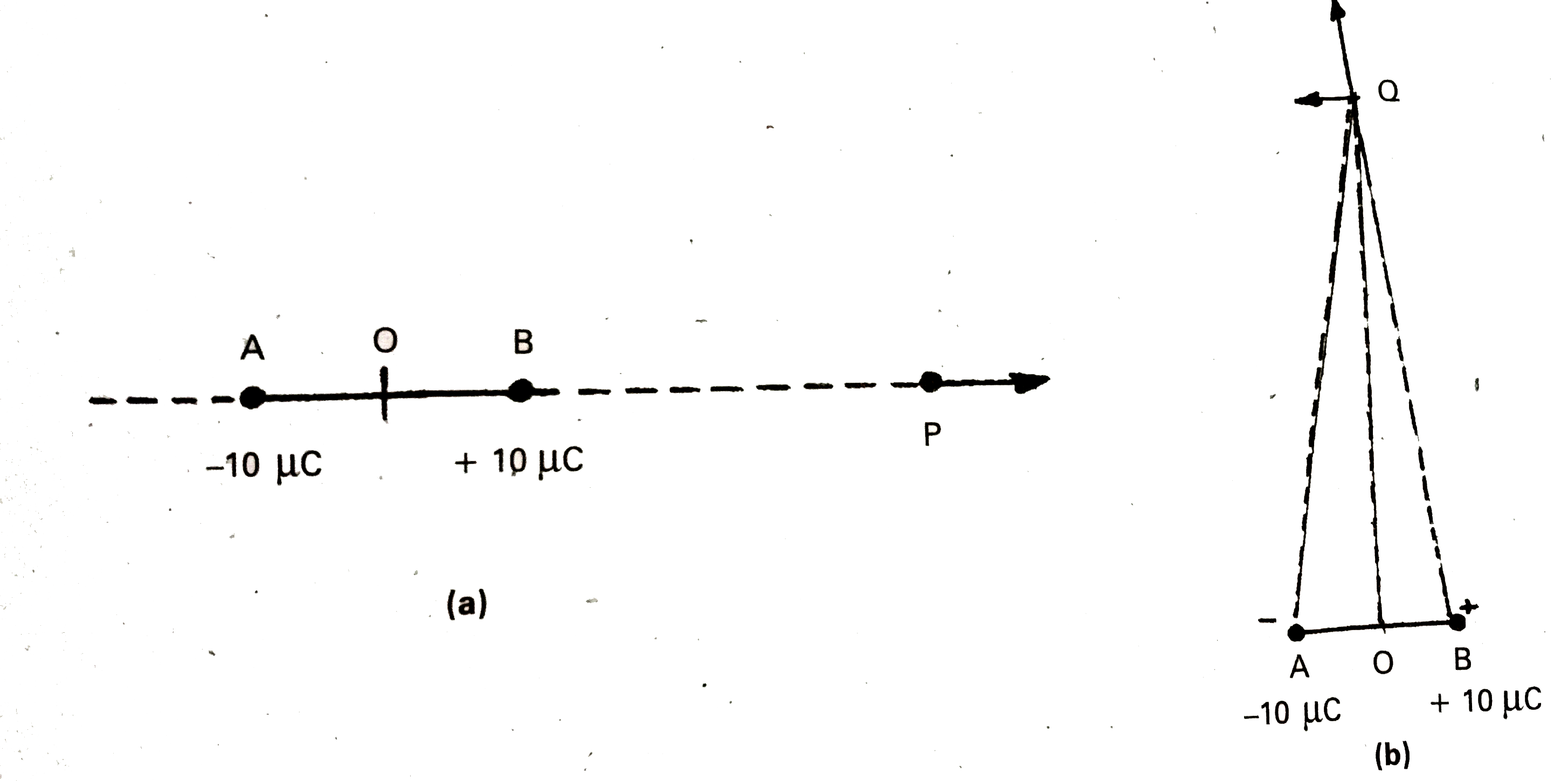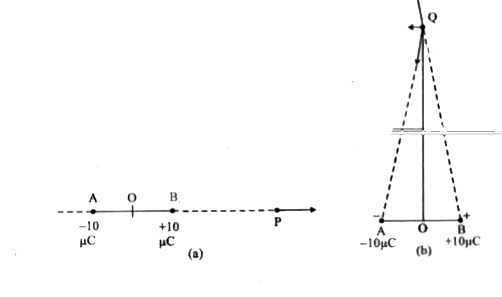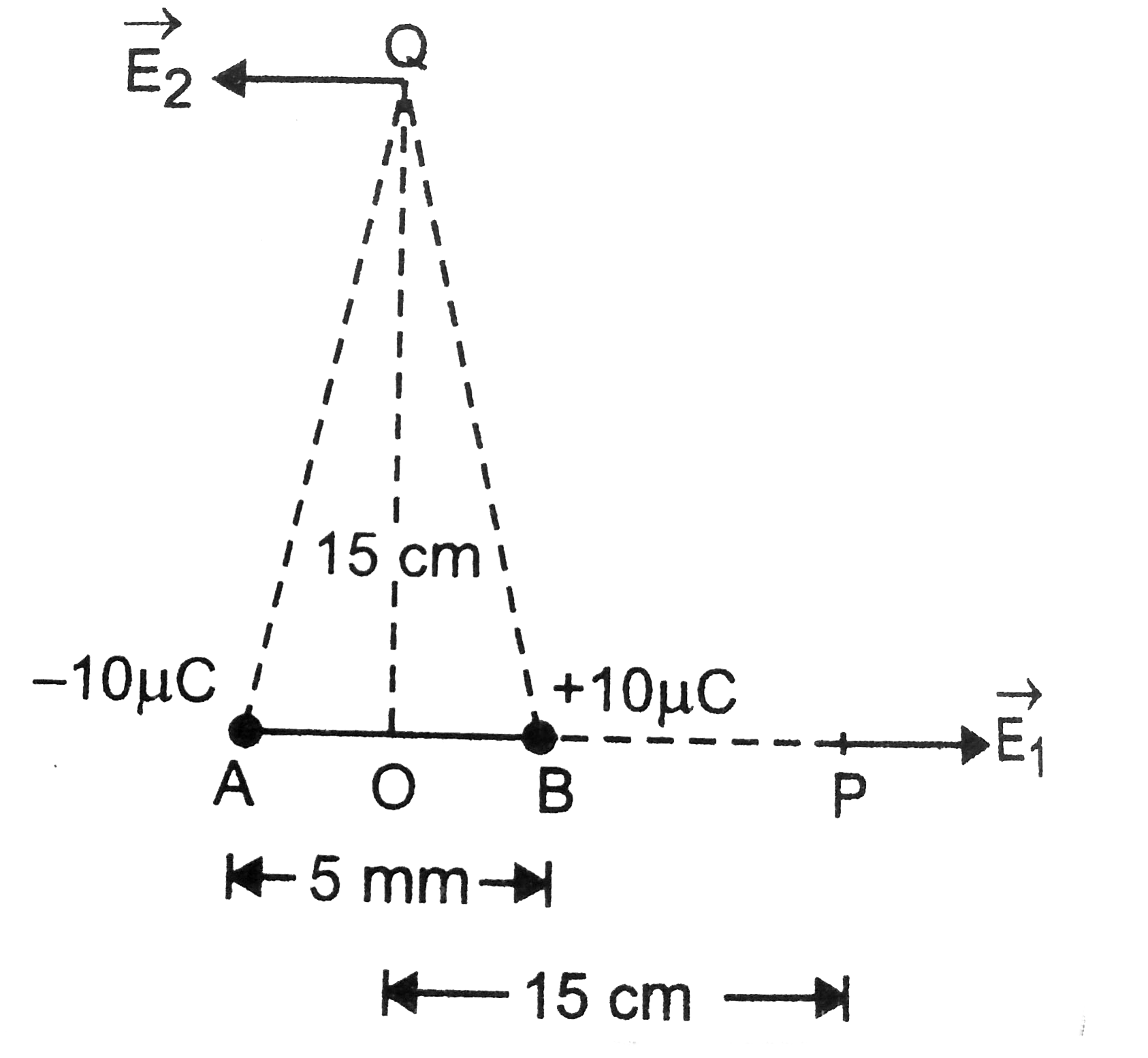Two charges 10μC are placed 5.0 mm apart. Determine the electric field at a point P on the axis of the dipole 15 cm away from its centre O on the side of the positive charge, as shown in Fig.
 Solution in Telugu
Solution in Telugu
Field at P due to charge +10μC
=10−5C4π(8.854×10−12C2N−1m−2)×1(15−0.25)2×10−4m2
=4.13×106NC−1 along BP
Field at P due to charge −10μC
=10−5C4π(8.854×10−12C2N−1m−2)×1(15−0.25)2×10−4m2
=3.86×106NC−1 along PA
The resultant electric field at P due to the teo charges at A and B is 2.7×105NC−1 along BP.
In this example, the ratio OP/OB is quite large (= 60). Thus, we can expect to get approximately the same result as above by directly using the formula for electric field at a far-away point on the axis of a dipole. For a dipole consisting of charges ±1,2a distance apart, the electric field at a distance r from the centre on the axis of the dipole has a magnitude.
E=2p4πε0r3(ra>>1)
Where p = 2aq is the magnitude of the dipole moment.
The direction of electric field on the dipole axis is always along the direction of the dipole moment vector (i.e., from -q to q). Here,p=10−5×C,5×10−3m=5×10−8Cm
Therefore,
E=2×5×10−8Cm4π(8.854×10−12C2N−1m−2)×1(15)3×10−6m3=2.6×105NC−1.
Along the dipolemoment direction AB, which is close to the result obtained earlier.
Topper's Solved these Questions
- BOOK - VIKRAM PUBLICATION ( ANDHRA PUBLICATION)CHAPTER - ELECTRIC CHARGES AND FIELDSEXERCISE - VERY SHORT ANSWER QUESTIONS13videos
ELECTRIC CHARGES AND FIELDS
- BOOK - VIKRAM PUBLICATION ( ANDHRA PUBLICATION)CHAPTER - ELECTRIC CHARGES AND FIELDSEXERCISE - SHORT ANSWER QUESTIONS6videos
ELECTRIC CHARGES AND FIELDS
- BOOK - VIKRAM PUBLICATION ( ANDHRA PUBLICATION)CHAPTER - DUAL NATURE OF RADIATION AND MATTEREXERCISE - DAM SURE (VSAQ)2videos
DUAL NATURE OF RADIATION AND MATTER
- BOOK - VIKRAM PUBLICATION ( ANDHRA PUBLICATION)CHAPTER - ELECTROMAGNETIC INDUCTION EXERCISE - Additional EXERCISES15videos
ELECTROMAGNETIC INDUCTION
Similar Questions
What is meant by the statement 'charge is quantized' ?
03:06View SolutionState and explain Coulomb's incerse square law in electricity.
03:45View SolutionThe wavelength of electromagnetic radiation is doubled. What will happen to the energy of the photons of the new radiation ?
08:25View SolutionSuppose the loop in Textual Exercise 4 is stationary but the current feeding the electromagnet that produces the magnetic field is gradually reduced so that the field decreases from its initial value of 0.3 T at the rate of 0.02Ts−1 .If the cut is joined and the loop has a resistance of 1.6Ω how much power is dissipated by the loop as heat ? What is the source of this power ?
05:01View SolutionTwo charges +- 10 mu C are placed 5*0 mm apart. Determine the electric field at (a) point P on the axis of dipole 15 cm away from its center on the side of the positive charge. As shown in Figure and at (b) a point Q. 15 cm away form O on a line passing through O and a line passing through O and normal to the axis of the dipole as shown in Fig.
07:41View SolutionTwo charges +20muC and -20muC are placed 10mm apart. The electric field at point P, on the axis of the dipole 10 cm away from its centre O on the side of the positive charge is
04:54View Solution±10μc के दो आवेश एक - दूसरे से 5.0 mm की दुरी पर स्थित हैं । (a ) इस द्विध्रुव के अक्ष पर द्विध्रुव के केंद्र O से चित्र (a ) में दर्शायें अनुसार , धनावेश की और 15 सेमी दुरी पर स्थित किसी बिंदु p पर तथा (b ) द्विध्रुव के अक्ष के अभिलंबवत O से चित्र (b ) के अनुसार गुजरने वाली रेखा से 15 सेमी दुरी पर स्थित किसी बिंदु Q पर विद्युत - क्षेत्र का मान ज्ञात कीजिए ।
 View Solution
View SolutionTwo charges 10 muC are placed 5.0 mm apart. Determine the electric field at a point Q, 15 cm away from O on a line passing through O and normal to the axis of the dipole, as shown in Fig.
08:35View Solution±10μC के दो आवेश 5.0mm की दुरी पर स्थित है। (a ) द्विध्रुव के मध्य-बिंदु से 15 cm की दुरी पर अक्षीय स्थिति में एवं (b ) मध्य-बिंदु से 15 cm की दुरी निरक्षीय स्थिति में विधुत क्षेत्र की तीव्रता ज्ञात कीजिए।
02:59View SolutionTwo charges ±10μC are placed 5.0 mm apart. Determine the electric field at (a) a point P on the axis of the dipole 15 cm away from its centre O on the side of the positive charges, as shown in Fig. (a) and (b) be a point Q, 15 cm away from O on a line passing through O and normal to the axis of the dipole, as shown in Fig (b).
 02:44View Solution
02:44View SolutionTow charges pm10 mu C are placed 5.0 mm apart determine the electric field at (a) a point p on the axis of the dipole 15 cm away from its centre o ont the side of the positive charge as (a) and (b) a point q 15 cm away from o on a line passing through o and normal to the axis of the dipole as
03:02View SolutionTow charges pm10 mu C are placed 5.0 mm apart determine the electric field at (a) a point p on the axis of the dipole 15 cm away from its centre o ont the side of the positive charge as (a) and (b) a point q 15 cm away from o on a line passing through o and normal to the axis of the dipole as
02:16View SolutionTwo charges ±10μC are placed 5⋅0mm apart. Determine the electric field at (a) point P on the axis of dipole 15cm away from its center on the side of the positive charge. As shown in Figure and at (b) a point Q. 15cm away form O on a line passing through O and a line passing through O and normal to the axis of the dipole as shown in Fig.
 02:57View Solution
02:57View SolutionTwo charges of dipole +- 10 mu C are placed 1mm apart. Determine the electric field at a point on the axis of the dipole 10 cm away from its centre and at 10 cm away from centre on the equator of the dipole.
02:41View SolutionTow charges ±10μ C are placed 5.0 mm apart determine the electric field at (a) a point p on the axis of the dipole 15 cm away from its centre o ont the side of the positive charge as (a) and (b) a point q 15 cm away from o on a line passing through o and normal to the axis of the dipole as
 03:52View Solution
03:52View Solution

